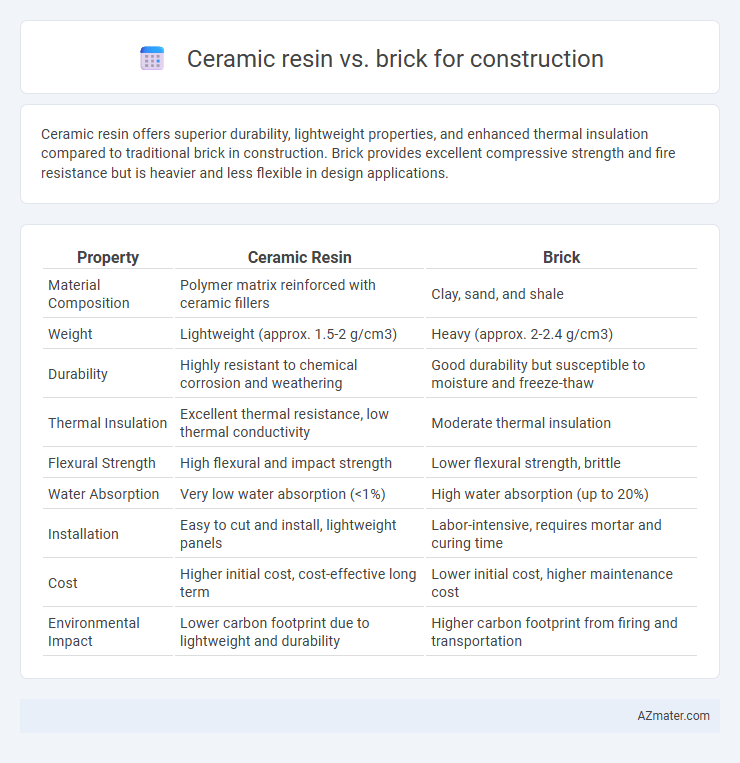Ceramic resin offers superior durability, lightweight properties, and enhanced thermal insulation compared to traditional brick in construction. Brick provides excellent compressive strength and fire resistance but is heavier and less flexible in design applications.
Table of Comparison
| Property | Ceramic Resin | Brick |
|---|---|---|
| Material Composition | Polymer matrix reinforced with ceramic fillers | Clay, sand, and shale |
| Weight | Lightweight (approx. 1.5-2 g/cm3) | Heavy (approx. 2-2.4 g/cm3) |
| Durability | Highly resistant to chemical corrosion and weathering | Good durability but susceptible to moisture and freeze-thaw |
| Thermal Insulation | Excellent thermal resistance, low thermal conductivity | Moderate thermal insulation |
| Flexural Strength | High flexural and impact strength | Lower flexural strength, brittle |
| Water Absorption | Very low water absorption (<1%) | High water absorption (up to 20%) |
| Installation | Easy to cut and install, lightweight panels | Labor-intensive, requires mortar and curing time |
| Cost | Higher initial cost, cost-effective long term | Lower initial cost, higher maintenance cost |
| Environmental Impact | Lower carbon footprint due to lightweight and durability | Higher carbon footprint from firing and transportation |
Introduction to Ceramic Resin and Brick
Ceramic resin is a composite material combining ceramic powders with a resin binder, offering high durability, lightweight properties, and excellent resistance to corrosion, heat, and wear, making it suitable for modern construction applications. Bricks, traditionally made from fired clay, provide strong structural support, thermal insulation, and weather resistance, having been a staple in building for centuries due to their natural and cost-effective qualities. Comparing these materials reveals distinct advantages in flexibility, maintenance, and environmental impact, influencing the choice based on project demands and sustainability goals.
Material Composition: Ceramic Resin vs Brick
Ceramic resin consists of advanced polymers combined with ceramic particles, offering enhanced durability and resistance to moisture compared to traditional clay bricks. Bricks are primarily composed of natural clay, sand, and water, which are molded and fired to achieve strength but may be more porous and prone to weathering over time. The fusion of resin and ceramic materials in ceramic resin products results in lighter, more flexible construction components with improved thermal insulation relative to conventional brick masonry.
Strength and Durability Comparison
Ceramic resin offers superior tensile strength and enhanced resistance to cracking compared to traditional brick, making it ideal for structures requiring flexibility and longevity. Bricks demonstrate high compressive strength and excellent thermal mass, contributing to durable walls that withstand environmental stresses over time. While ceramic resin provides improved durability against chemical and moisture damage, bricks maintain performance through fire resistance and weathering resilience, ensuring long-term structural integrity.
Thermal Insulation and Energy Efficiency
Ceramic resin offers superior thermal insulation compared to traditional brick, reducing heat transfer and maintaining stable indoor temperatures. This enhanced insulation property decreases reliance on heating and cooling systems, leading to significant energy savings and improved energy efficiency. Bricks, while durable, generally have higher thermal conductivity, resulting in increased energy consumption for temperature regulation.
Cost Analysis: Affordability and Investment
Ceramic resin offers a cost-effective alternative to traditional brick, with lower material and installation expenses contributing to reduced initial investment. Bricks typically incur higher upfront costs due to labor-intensive masonry work and longer curing times, impacting overall project budgets. Long-term maintenance costs for ceramic resin are generally lower, enhancing its affordability as a sustainable construction material choice.
Installation Process and Labor Requirements
Ceramic resin panels offer a streamlined installation process due to their lighter weight and interlocking design, reducing labor time by up to 30% compared to traditional bricklaying. Brick construction demands skilled masons and longer curing times for mortar, often extending project duration and increasing labor costs. Prefabricated ceramic resin systems simplify on-site assembly, enhancing efficiency and minimizing the need for heavy equipment and specialized labor.
Environmental Impact and Sustainability
Ceramic resin panels offer a lower carbon footprint compared to traditional bricks due to their reduced energy consumption during manufacturing and lighter weight, which decreases transportation emissions. Bricks require high-temperature firing processes that emit significant CO2, contributing to environmental degradation, whereas ceramic resins often incorporate recycled materials and can be more easily recycled at end-of-life. The durability and insulation properties of ceramic resin improve energy efficiency in buildings, enhancing sustainability by reducing heating and cooling demands over the structure's lifecycle.
Aesthetic Flexibility and Design Options
Ceramic resin offers superior aesthetic flexibility compared to traditional brick, allowing for a wide range of colors, textures, and shapes that can mimic natural materials or embrace modern design trends. Unlike bricks, which have a more uniform and rustic appearance, ceramic resin can be molded into intricate designs and customized finishes to suit diverse architectural styles. This versatility makes ceramic resin an ideal choice for projects prioritizing unique visual appeal and innovative design options.
Maintenance and Longevity Differences
Ceramic resin offers superior resistance to weathering, staining, and cracking compared to traditional brick, resulting in lower maintenance needs over time. Bricks require periodic repointing and sealing to prevent moisture infiltration and structural degradation, increasing long-term upkeep costs. The inherent durability of ceramic resin extends the lifespan of construction elements, often exceeding 50 years with minimal intervention, whereas brick longevity varies widely based on environmental exposure and maintenance quality.
Choosing the Best Material for Your Project
Ceramic resin offers lightweight, high durability, and superior moisture resistance compared to traditional brick, making it ideal for modern construction projects aiming for longevity and low maintenance. Brick provides unmatched thermal mass and natural insulation, enhancing energy efficiency and offering a classic aesthetic appeal suited for both residential and commercial buildings. Selecting the best material depends on factors such as climate conditions, structural requirements, budget constraints, and design preferences, ensuring the chosen option aligns with the specific needs and goals of your construction project.

Infographic: Ceramic resin vs Brick for Construction
 azmater.com
azmater.com